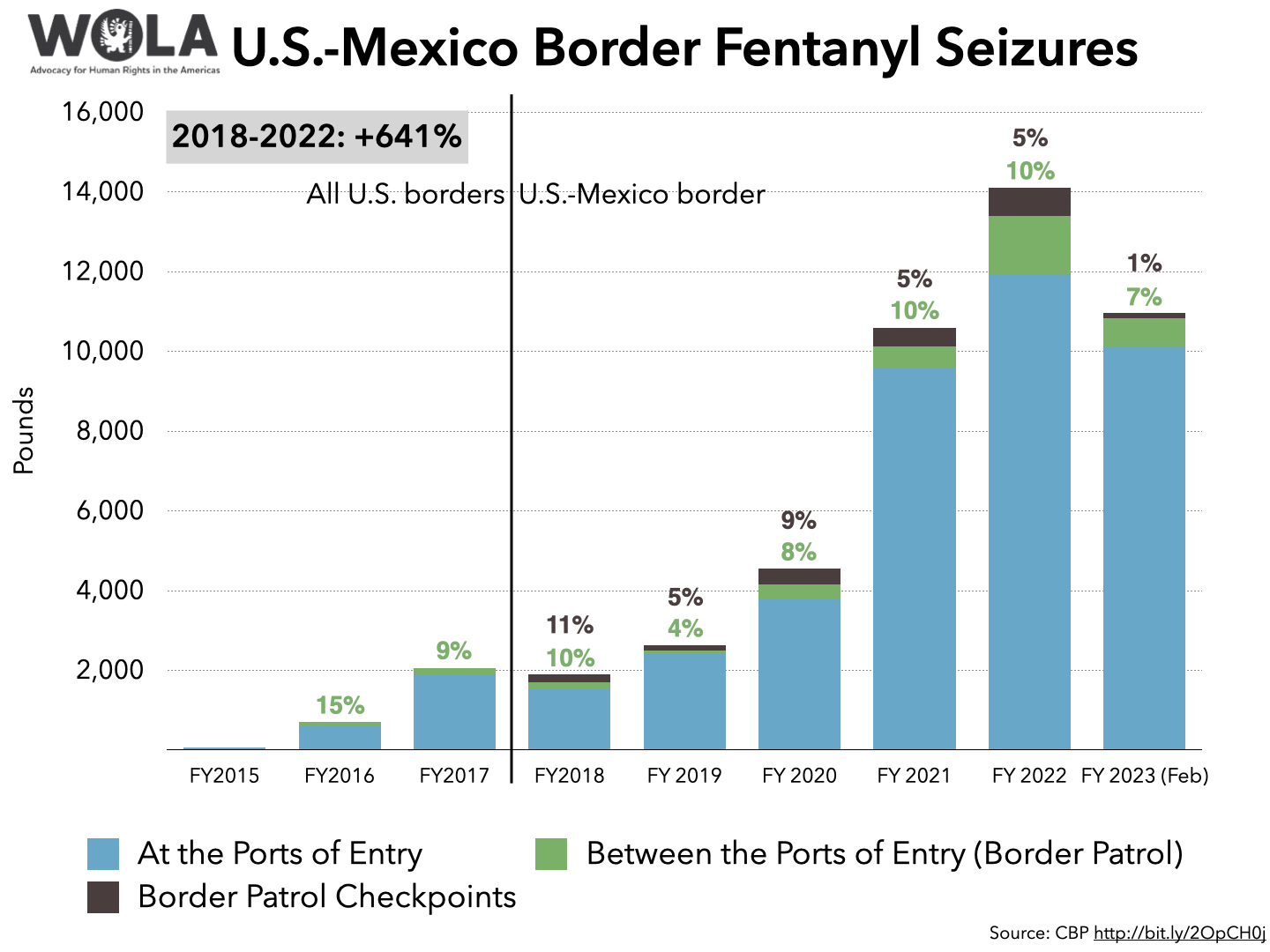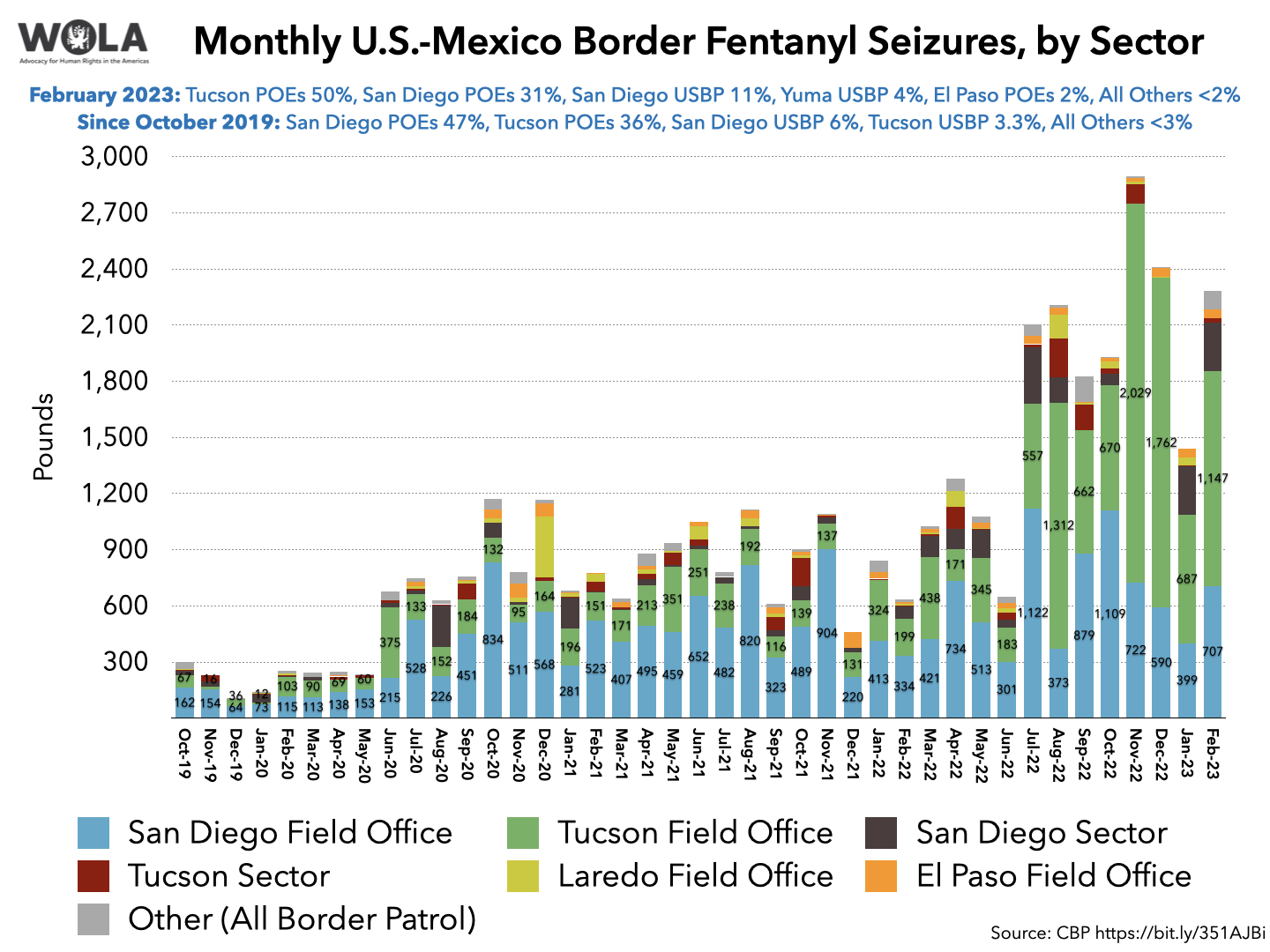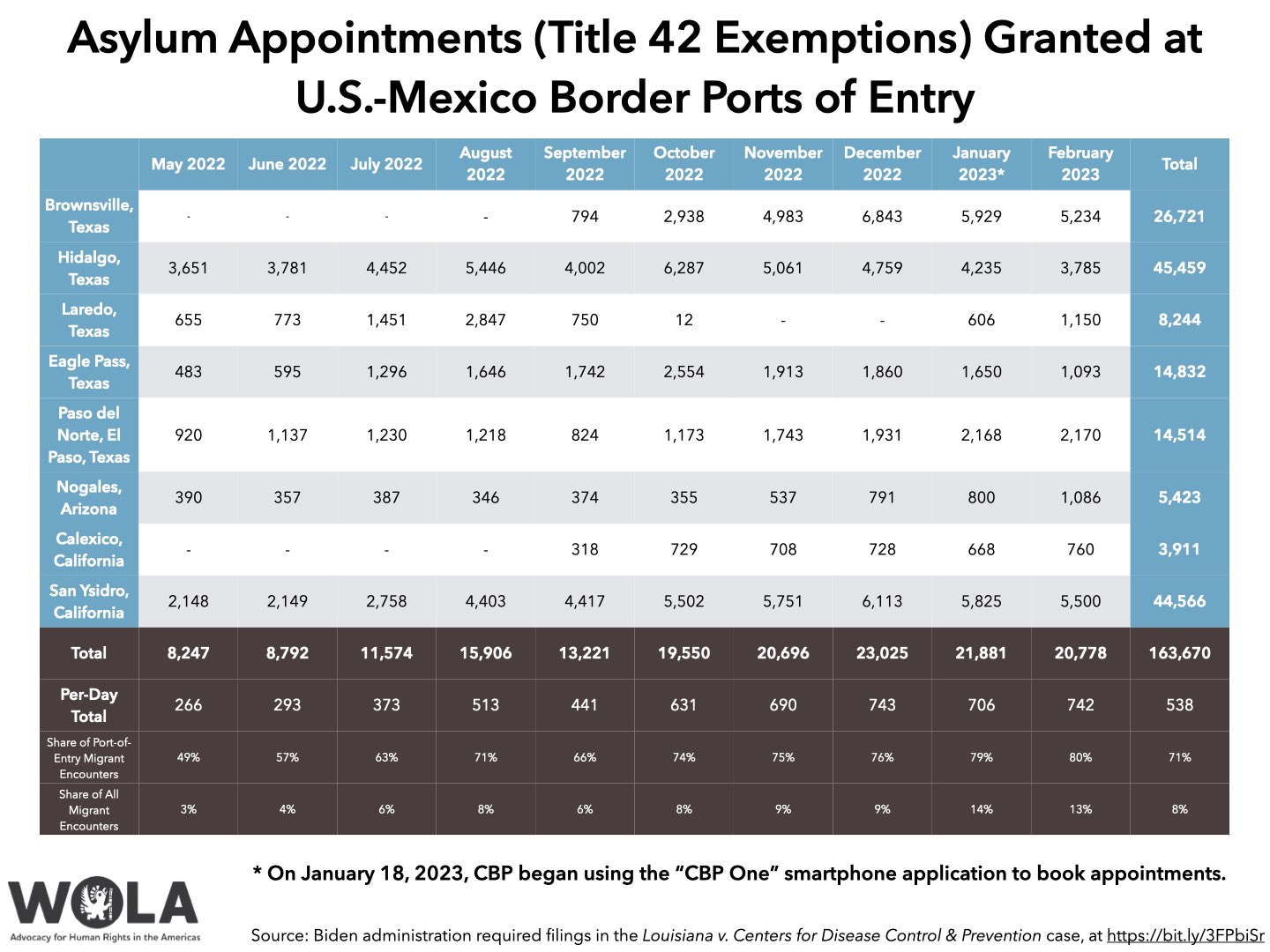With this series of weekly updates, WOLA seeks to cover the most important developments at the U.S.-Mexico border. See past weekly updates here.
Department of Homeland Security (DHS) Secretary Alejandro Mayorkas visited the Mariposa port of entry in Nogales, Arizona on March 21 to commemorate the launch of “Operation Blue Lotus,” a “surge operation” targeting cross-border fentanyl smuggling, which is now increasingly happening in Arizona.
With an increase in targeted inspections and recent installation of a “multi-energy portal (non-intrusive inspection technology or NII)” scanner at the Mariposa port, Mayorkas said that the operation had led to 18 drug seizures during its first week (March 13-19), including “over 900 pounds of fentanyl, over 700 pounds of methamphetamines, and over 100 pounds of cocaine.” The “portal” is the first of two that DHS expects to install at the Nogales border crossing.
The 900 pounds of fentanyl seized in a week is equal to about 19 days’ worth of CBP’s Arizona seizures in February, when the agency confiscated 1,300 pounds of the potent opioid.
The U.S. Drug Enforcement administration considers 2 milligrams of fentanyl to be a “potentially lethal dose;” if the 900 pounds seized were one-half pure, then they would be about 100 million such doses. That traffickers ( reportedly dominated by Mexico’s Sinaloa and Jalisco cartels) are willing to risk losing so much product indicates how cheap fentanyl is to produce, and how compact and easy to smuggle it is.
Since October 2022 (the start of the government’s 2023 fiscal year, which is on pace to break past years’ records), 92 percent of U.S. border authorities’ fentanyl seizures have occurred at ports of entry, the official border crossings. The remaining 8 percent was seized by Border Patrol agents between the ports of entry.

Breaking down this seizure data by month and sector shows a significant shift, starting in the summer and fall of 2022. San Diego (blue and brown on the below chart) had long made up the overwhelming majority of border fentanyl seizures. Rather suddenly, Arizona (green, plus the small red bits) is now where more than half of the drug appears to be crossing.

Mexico’s president, Andrés Manuel López Obrador, caused a stir over the past two weeks by repeatedly claiming, without evidence, that Mexico does not produce fentanyl. His own presidential security briefings, most recently on March 7, along with military press releases, document large-scale seizures of the drug. While López Obrador sought to clarify that Mexican organized crime only has pill presses and does not manufacture the drug itself, the Wall Street Journal was able to visit a fentanyl lab in Sinaloa in 2022.
The Biden administration’s most recent court filing (dated March 16), the result of a Republican states-led lawsuit to preserve Title 42, includes statistics about asylum-seeking migrants who were able to secure appointments at border ports of entry using the “CBP One” smartphone app in February.
20,778 asylum seekers, 742 per day, were able to secure appointments under a system of Title 42 exemptions. That is up from 706 per day in January (21,881 total), when DHS switched—on January 18—from a less-formal Title 42 exemptions system to full use of the CBP One app.

As noted in several past Border Updates, migrants seeking appointments continue to experience problems with the app, including lack of internet access while fleeing, frequent crashes, limited languages (error messages are in English), and a facial capture feature that is widely reported as not responding to people with darker skin. The largest issue, though, continues to be the small number of daily appointments available, a fraction of current levels of protection-seeking migration.
In Nogales, Sonora, Arizona Luminaria reported from the Kino Border Initiative shelter where volunteers are trying to help migrants navigate CBP One. Over 1,000 miles east, in Matamoros, the Border Chronicle visited volunteers from the Sidewalk School who were playing a similar “tech support” role with the app.
“It can also be traumatizing to have your family’s safety come down to luck with an app,” Chelsea Sachau of the Tucson-based Florence Immigrant and Refugee Rights Project told Arizona Luminaria. “Many of the people we serve have told us they feel powerless to protect their kids and families when they aren’t able to get an appointment despite trying every morning.”
Community members gathered on March 18, at a location south of San Diego near where the border wall runs into the Pacific Ocean, to protest the Biden administration’s plans to build a higher barrier through a site known as “Friendship Park.” They were joined by two state legislators and by San Diego-area Rep. Juan Vargas (D-California), whose 52nd congressional district is the southwestern-most in the continental United States.
Friendship Park, an area of California’s Border Field State Park, got its name from First Lady Pat Nixon, who toured it in 1971. “At the time there was only a barbed-wire fence there that divided the U.S. and Mexico,” Pedro Ríos of AFSC San Diego, a prominent voice in the Friends of Friendship Park movement, told the Border Chronicle.
For decades, it was a site where families and friends separated by migratory status could meet, share items, and eat meals together. After taller fencing went up in the 2000s, such encounters happened through the border wall’s bollards. After Border Patrol put up a double layer of fencing, visitors to Friendship Park had to come at designated times when agents would open up a gate in the inner wall.
In 2020, before pandemic closures began, Border Patrol entirely stopped allowing these visits. “First because of COVID,” Ríos said. “Then they said because of the violence in Mexico. Another one was that the primary border wall was unsound structurally, and that anyone could easily tip it over, which is as ridiculous as it sounds.”
The park has not reopened. In 2022 the Biden administration, compelled by Trump-era congressional appropriations that have not been rescinded, began moving forward on plans to replace the park’s existing border barriers with two higher, 30-foot walls. A public outcry, led by Friends of Friendship park, forced some revision to the construction plan, like a segment of outer wall that would be 18 feet tall instead of 30 feet. These modifications, community members contend, “are not enough to preserve the essence and intended message of the park,” the Los Angeles Times reported.
Rep. Vargas had strong words at the March 18 rally. “We don’t need this wall, this wall does nothing,” he said, adding that Customs and Border Protection (CBP) Commissioner Chris Magnus had pledged to work with the community before his forced November 2022 resignation. “He agreed to work with us, and then they fired him. They literally fired him,” Rep. Vargas said in the Los Angeles Times, adding that Magnus’s successor, Acting Commissioner Troy Miller, hasn’t been willing to listen. Vargas even said that he might consider joining Republican efforts to impeach DHS Secretary Mayorkas because “he betrayed us” on Friendship Park.
AFSC’s Ríos recalled that higher walls will mean more injuries and deaths. A January 27 document from the Mexican Consulate in San Diego listed at least 23 “wall related” fatalities of Mexican citizens in San Diego in 2021 and 2022.